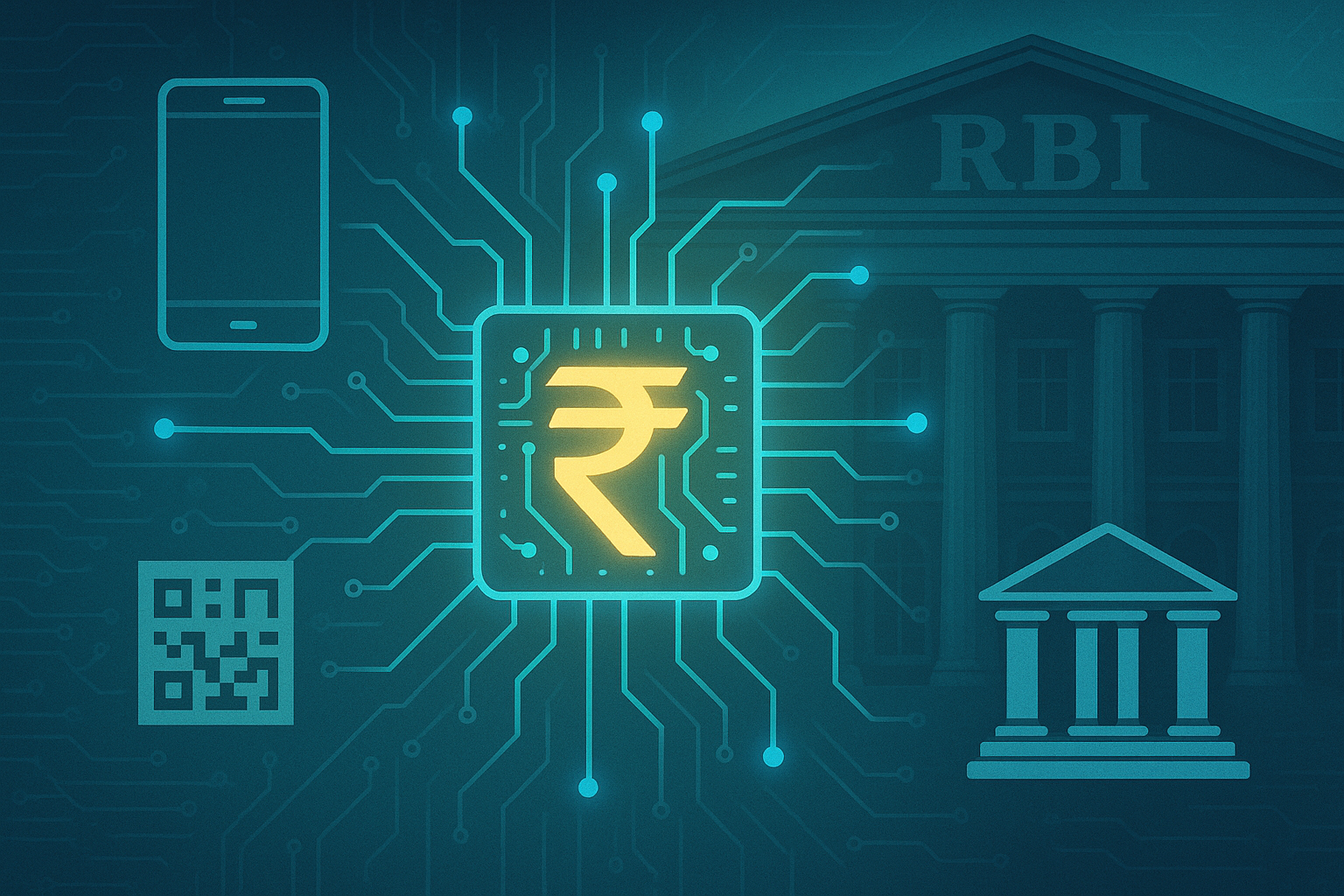As digital payments become the norm and cryptocurrencies continue to evolve, central banks worldwide are exploring or launching Central Bank Digital Currencies (CBDCs) to modernize monetary systems, enhance payment efficiency, and counter the rise of private digital currencies. India’s own CBDC journey took a significant step with the Reserve Bank of India (RBI) launching the Digital Rupee (e₹) pilot for both retail and wholesale segments. This article delves into the motivations behind CBDCs, the structure of RBI’s digital currency initiative, international comparisons, and what lies ahead for sovereign-backed digital currencies.
Background and Context
The concept of a CBDC refers to a digital version of a country’s fiat currency, issued and regulated by the central bank. Unlike cryptocurrencies like Bitcoin or Ethereum, CBDCs are fully sovereign and legally backed, combining the efficiency of digital payments with the trust of traditional money.
In India, the RBI launched its wholesale CBDC pilot in November 2022 and followed it with a retail pilot in December 2022, involving select banks and users in cities like Mumbai, Delhi, Bengaluru, and Bhubaneswar. The goal: test real-time use cases such as interbank settlements, merchant payments, and person-to-person (P2P) transfers.
As of mid-2025, over 1.2 million users and 2 lakh merchants have interacted with the Digital Rupee across pilot phases, marking it as one of the largest live retail CBDC tests in the world.
Key Features of the Digital Rupee (e₹)
Two-Tier Model
The RBI’s CBDC operates on a two-tier system:
Tier 1: The RBI issues digital currency to selected banks.
Tier 2: Banks distribute it to users via mobile wallets or banking apps.
Offline Capability
The RBI is also testing offline functionality for remote and low-connectivity regions, using QR codes and near-field communication (NFC).
Token-Based for Retail
Retail CBDC (CBDC-R) is token-based, similar to physical cash. This ensures anonymity in transactions, a key public concern.
Account-Based for Wholesale
Wholesale CBDC (CBDC-W) is account-based and targets interbank settlements and securities transactions, replacing RTGS or collateralized lending mechanisms.
Global Landscape and Comparisons
India is not alone in its CBDC ambitions. According to the Atlantic Council CBDC Tracker (2025):
11 countries have launched full-scale CBDCs (e.g., Nigeria’s eNaira, Bahamas’ Sand Dollar).
21 countries, including China (e-CNY) and Sweden (e-Krona), are in advanced pilot stages.
The European Central Bank (ECB) is preparing for a digital Euro rollout by 2026.
The US Federal Reserve is studying a digital dollar, focusing on cross-border use and privacy safeguards.
“India’s Digital Rupee is unique in its hybrid model and focus on retail adoption at scale,” notes an IMF working paper on CBDCs in emerging economies.
Motivations and Strategic Goals
Modernizing Payments Infrastructure
CBDCs aim to enhance the efficiency, resilience, and inclusivity of digital payments, especially in underserved regions.
Curbing Black Money and Enhancing Transparency
A traceable yet privacy-respecting CBDC could reduce cash-based black economy activity, enabling better tax compliance.
Countering Crypto Risks
By offering a safe and regulated digital alternative, CBDCs serve as a counterweight to unregulated cryptocurrencies that pose systemic risks.
Boosting Financial Inclusion
With simplified access through mobile wallets and offline functionality, the Digital Rupee can reach populations with limited access to banks.
Industry Perspectives
Shaktikanta Das, RBI Governor, emphasized in a 2025 monetary policy statement:
“The Digital Rupee is designed to complement—not replace—physical cash and digital banking. It will offer the benefits of crypto without the associated risks.”
Rachit Garg, CTO of a payment fintech startup:
“CBDCs will enable programmable money—allowing automation of subsidies, pension payouts, and even micro-loans directly via smart contracts.”
Neha Gupta, Economist at NIPFP, cautioned:
“The impact of CBDCs on bank disintermediation must be carefully monitored. A sudden migration from deposits to digital rupees could affect bank lending capacity.”
Social Media Reactions from Industry Watchers
@DigitalINRwatch:
“India’s CBDC is no longer theory—it’s a working pilot with over a million users. Big step for sovereign digital currency. #DigitalRupee #CBDCIndia”
@FintechPolicyIN:
“RBI’s Digital Rupee pilot is a model for emerging markets. Secure, scalable, and inclusive. #CBDC #FintechIndia”
@CryptoPolicyAsia:
“CBDCs are governments’ answer to crypto’s rise. India’s approach shows how to balance innovation with control. #CBDCvsCrypto”
Challenges and Risks
User Privacy vs Traceability:
Balancing individual anonymity with government oversight is one of the most complex design challenges for CBDCs.Technology Infrastructure:
Ensuring uptime, cybersecurity, and interoperability with legacy systems will be critical.Adoption Incentives:
Public trust and merchant acceptance are key. Without strong incentives, digital rupee usage may remain limited.Banking Disruption:
If individuals shift significant deposits into CBDCs, traditional banks could face funding pressures, affecting credit availability.
Future Outlook
The RBI is expected to expand its retail pilot to Tier 2 and rural cities by early 2026, potentially integrating with the UPI ecosystem for broader accessibility. Globally, collaboration on cross-border CBDC corridors is emerging, with the BIS Innovation Hub leading multi-country projects.
CBDCs could redefine monetary policy transmission, cross-border remittances, and digital identity frameworks. However, success will depend on public trust, regulatory guardrails, and continued innovation.
Conclusion
The Digital Rupee positions India at the forefront of the global CBDC race, offering a sovereign, digital complement to its already vibrant payments ecosystem. As central banks worldwide explore or roll out their versions, India’s experience will be closely watched. With continued pilots, stakeholder engagement, and cautious innovation, the RBI aims to build a CBDC that is scalable, inclusive, and future-ready.












